Dormant period
Bulbous plants cannot bloom constantly, moreover, after the end of the flowering period, the plant needs to recuperate. Vallota is no exception. This flower is characterized by a seasonal rhythm of life - the alternation of the growth phase and the resting phase. The task of the grower in this situation is to correctly understand the needs of the plant and provide it with optimal conditions corresponding to each phase.
- watering - limited, but not completely stopped; the plant should receive a minimum of moisture, which prevents the bulb from completely drying out, but does not give it the strength to grow;
- feeding - stopped;
- temperature - lowered to 12-15 ºC (some species need even cooler air).
However, the change in the temperature regime in the resting phase is not critical for the vallota; it is much more important to reduce the intensity of watering and feeding. However, it is worth removing the pot in a darker and cooler place, if only because in this phase the flower completely loses its decorative effect and is not at all pleasing to the eye.
Did you know? Some varieties of vallottes, especially those obtained by crossing with other plants, have their own "views" on the seasonal change of phases of life. For example, there are hybrids that bloom in winter and, accordingly, hibernate in summer. But the most unusual, perhaps, is the so-called "fire lily", which blooms only when there is a strong fire, and there is a large amount of smoke in the air.
Unlike many other flowering plants, dormant cyrtantus should not completely shed its foliage. Moreover, if you cut it off, the flower will react very painfully to such a procedure. However, slightly withered and dried leaves during this period are considered a normal phenomenon, you should not worry about this.
It is also important to know that the alternation of periods of growth and dormancy described above is characteristic only of adult specimens. Young bulbs should be watered and fed throughout the year without interruption, so they form faster and reach the size necessary for the beginning of flowering.
Features of home care
The homeland of the decorative flower is South Africa, but an ordinary Russian apartment is perfect for the beauty.
Now in floriculture there is no clear classification of the name of the genus, the species of this bulbous plant. The question is varied.
Today we are talking about a flower - beautiful Vallotaspeciosa. A delightful bulbous plant, a representative of the Amaryllis family has long longitudinal leaves, bright - more often purple (shades are possible) flowers collected by inflorescences.
Growing
Vallota speciosa is easy to grow with simple plant and floriculture rules. Does not require special conditions. There are problems, look for the reason: the flower pot is not suitable, the soil does not meet the necessary parameters, the temperature and light regime is violated, there is no rest period. Eliminate the found cause, then the beautiful Vallota will thank you with her beauty.
Landing
Planting is traditionally done with a bulb. This part should remain open one third at a time. Proper landing will prevent decay.
Transfer
It is hardly worth replanting unnecessarily. The bulbous plant prefers tight containers. A transplant is permissible only once every two to three years.
Sometimes in the summer open-ground planting is preferable. Not all experts recommend this procedure. Business is the master's.
Pruning
Vallota speciosa does well without pruning.You need to trim the leaves affected by the heat so that the decorative look remains attractive.
A bulbous plant is difficult to bear with abundant watering: the bulb will quickly rot, the flower will die. The soil of the flowerpot should only be slightly damp.
Temperature
The room temperature is quite satisfactory for the decorative flower Vallota is beautiful.
Plus or minus 24 degrees is the optimal temperature regime in spring and summer. Above 25 degrees is fatal.
The end of autumn has come, winter has come. A faded bulbous plant saves a cool climate: from 5 to 10 degrees. Let him rest, gain strength for a new flowering.
Important! Vallota speciosa is afraid of drafts, sudden temperature changes. It is contraindicated to place a decorative flower under open vents.
When taking out the plant to the balcony, pay attention: the wind may be blowing
Lighting
There are no big requirements for lighting, there are preferences inherent in bulbous plants. Vallota speciosa works well with light sources. Perfectly tolerates direct sunlight. True, it is dangerous to keep constantly under the aggressive sun in the summer heat.
It is preferable to place the bulbous plant near the western, eastern windows of the apartment. The north is bad. The beautiful Vallota prefers the sun over dark with coolness.
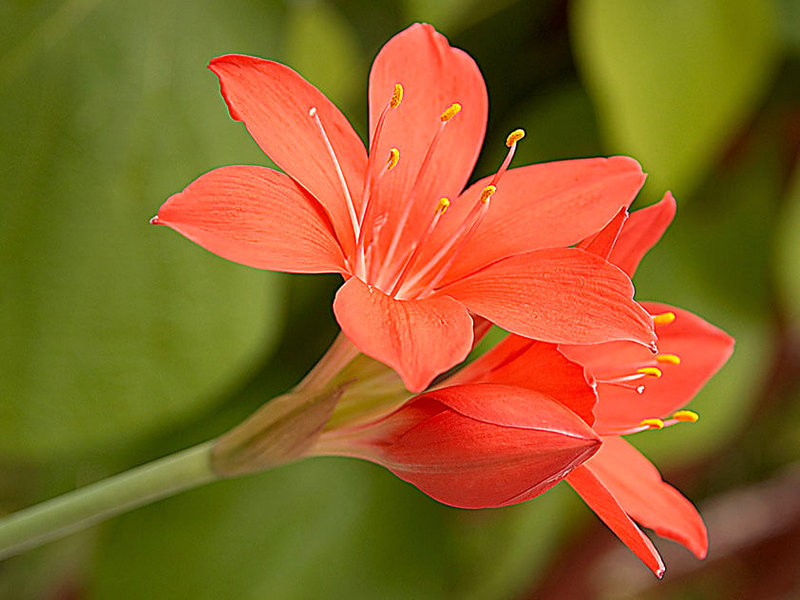
In the summer, a caring hostess brings out a decorative flower "for a walk" on the balcony. Short air-solar procedures will delight her.
Valotta: plant varieties
Among domestic cultures, there are only a few types of Valotta.
- Vallota is beautiful. The leaves of the plant are dark green, 35-45 cm long, the medium-sized bulb is 4-5 cm. It begins to bloom, mainly in autumn or at the end of the flight. Up to 9 red umbrella flowers are formed on the peduncle.
- Vallota is white. It is very easy to confuse this species with a lily. Although the flowers of the bush are not pure white, but with a creamy tint. The leaves are xiphoid, bright green. 5-7 flowers are formed on the peduncle. It blooms in spring or autumn.
- Vallota purple. The species is distinguished by larger, wider leaves. Their length reaches 35 cm. 5-8 flowers on a peduncle flaunt a bright purple hue against a background of olive leaves. Blooms more often in autumn.
- Vallota is pink. The rarest species. By all external features, it is similar to the white valotta, but differs only in a pale pink shade of flowers.
Wallot care
If a plant such as vallotta has appeared in the house, care and cultivation of this flower at home will not cause difficulties. By adhering to simple and uncomplicated rules, you can achieve long flowering and disease resistance. The plant loves light, so it is best placed on a sunny windowsill on the east side.
If the air temperature rises above 25 degrees, then it is necessary to systematically spray the leaves. In the heat, caring for a wallot at home is to increase the frequency of watering.
Note! When spraying, care must be taken that water droplets do not fall on the flower petals. During the growth period, the flower should be watered moderately.
Watering is carried out if the topsoil is dry. In winter, the frequency of watering decreases, depending on the ambient temperature. It is not necessary to allow the leaves to die off - this is poorly displayed on the state of the entire plant
During the growth period, the flower should be watered moderately. Watering is carried out if the topsoil is dry. In winter, the frequency of watering decreases, depending on the ambient temperature. It is not necessary to allow the leaves to die off - this is poorly displayed on the state of the entire plant.
Plant transplants are rare. This is due to the fact that it does not respond well to damage to the bulb.
Important! If the bulbs are damaged, then the plant begins to rot. The transplant is carried out every 2 or 3 years, necessarily in the spring, and only if there is a noticeable overgrowth of bulbs
During the planting process, you need to separate the babies from the bulbs (they require a lot of nutrients from the mother's bulb).It is better not to deepen the neck of the bulb into the ground. Make several holes in the pot to remove excess water. How drainage is used pebbles, sand
The transplant is carried out every 2 or 3 years, necessarily in the spring, and only if a strong growth of the bulbs is noticeable. During the planting process, you need to separate the babies from the bulbs (they require a lot of nutrients from the mother's bulb). It is better not to deepen the neck of the bulb into the ground. Make several holes in the pot to remove excess water. Pebbles and sand are used as drainage.
Why do the leaves turn yellow
Before winter, the plant does not lose leaves, but gets rid of old ones with the beginning of growth in spring. This process is natural and does not cause excitement. If young foliage turns yellow, this can be a dangerous sign. The plant should be examined for the presence of spider mites, mealybugs.

Vallotta bulbs
If the tips of the leaves turn yellow, this may be a signal of problems with the root system. For this, the irrigation system should be adjusted. If the room is cold, you need to raise the air temperature.
Temperature regime
In the summer, you need to keep the room temperature between 20 and 25 degrees. In winter, it is necessary to transfer the plant to a cooler place with a temperature of at least 10 and not higher than 12 degrees.
Soil and pot selection
To grow a plant, you need to choose a soil that is nutritious and rich in nutrients. For the mixture, combine turf, deciduous soil and humus (1 part of turf, 4 parts of deciduous soil and 2 parts of humus). Sand in the mixture is required.
Diseases, pests
Root rot is one of the most dangerous diseases for vallotta. Young, newly formed bulbs are especially affected by rot. When the root decays, the growth of the stems slows down, the leaves die off, the outer scales rot. Gray mold appears due to excessive moisture. The problem is eliminated by treating the plant with a solution of potassium permanganate, a fungicide.

Leaf damage
The plant can be affected by the scale insect and spider mites, aphids. To eliminate this phenomenon, drugs are used (Aktara, Aktellik). The shields are previously removed with a cotton swab soaked in an alcohol solution.
Preparing for flowering
In order for the plant to bloom, it cannot be transplanted into large pots. Better if it is a little tight. If there is a lot of space, the vallotta forms a large number of children, due to which flowering does not occur. Before flowering, you need to carefully separate the children.
Types and varieties
Vallota is represented by dozens of species, but in our latitudes, only two have successfully taken root in pots.
Vallota is beautiful. The long leaves of the plant are painted in deep green colors. Flowers are orange, burgundy and white. The latter are very rare.
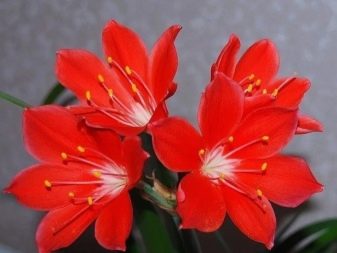
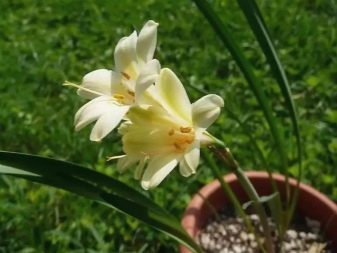
Vallota purple. The size is smaller than the beautiful vallotta: the leaves are thinner, the flowers are miniature. The foliage of the purple vallotta is painted in bright green tones. The name of the species comes from the purple color of the flowers.

In addition to species, there are also plant varieties. Two varieties of the whole variety are also popular among flower growers.
Vallotta Pink Diamond. Very similar to miniature lilies. Pink Diamond flowers have a delicate light pink color and a yellow core. This type of vallotta is smaller than the classic beautiful one.
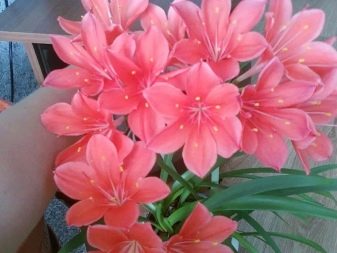
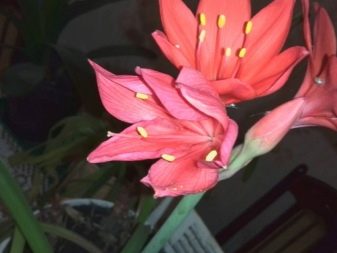
Vallota Creamy Beauty. Vallotta variety with bright green leaves and cream flowers. An interesting feature is its atypical flowering period. "Cremi Beauty", unlike other varieties and types of vallotta, blooms in autumn. Therefore, in the network you can find its colloquial name "autumn lily".

Breeding Vallotta
The easiest way is to propagate the vallot with baby bulbs, which are carefully separated from the mother's bulb or simply collected from the surface of the soil in a pot. Young bulbs are planted in separate small cups with soil mixture and holes in the bottom and a drainage layer
The bulbs are deepened into the ground by no more than half or 2/3.The flowering of a young plant occurs in 2-3 years.
Some varietal hybrids of cirtantus do not give children well. In this case, reproduction is carried out by the method of division: the parent bulb is cut into 2–4 parts so that each has roots. The incision sites are powdered with ash and dried a little. Then the delenki are planted in personal cups with soil mixture to root. Rooted plants will bloom in 3 years.
Seed propagation is rarely used. It is usually held in October or November. The seeds are pre-soaked in a saturated solution of potassium permanganate and germinated between layers of moistened gauze or filter paper. Then sowing is carried out into the substrate to a depth of about 5 mm. Cover with glass or foil and germinate with bottom heating. Periodically, the shelter is removed to water and feed the seedlings. Shoots appear after 20 days. After 3.5 months, small bulbs are transplanted, completely immersed in the ground. Plants are watered moderately. A year later, in spring, the grown bulbs are transplanted so that the root collar is slightly visible above the soil surface. With seed propagation, the vallot will bloom in 3 years.
Diseases and pests. The poisonous sap of citantus does not repel spider mites. To combat them, you must thoroughly rinse the long leaves of the plant under running warm (about + 40 ° C) water. This procedure may need to be repeated several times.
Diseases are most often caused by a violation of the watering regime. In this case, cytantus can get sick with fungal infections: gray, black or red rot. The mushroom usually settles at the base of the stem, and quickly eats away the leaves. To combat various rot, they are treated with special fungicidal preparations.
Read more in the article Pests of indoor plants and measures to combat them.
Virulence. It must be borne in mind that this plant is poisonous - the leaves, roots and flowers of the plant contain toxins. Bulbs containing the highest concentration of poisonous juice, the active ingredient in which is the alkaloid lycorin, are especially dangerous. Large doses of the toxin cause vomiting and indigestion.
When the juice of the plant gets on the skin, it turns red, itching appears, therefore, all manipulations with the citantus must be done with the use of rubber gloves. And after working with the plant, you must thoroughly wash your hands and used tools with soap.
For a plant, it is better to choose a place out of the reach of children and pets.
Description of the vallot
Vallotta (namely "vallotta", not "valotta", because the plant is named after the French botanist Pierre Vallot, who first described the species, although in Latin it is the opposite - Valotta) is one of the numerous representatives of the Amaryllidaceae family. In nature, it is found mainly in South Africa (in the Cape Province). Lovers of indoor floriculture have known Vallotta for a long time - since the middle of the 17th century.
The appearance of the vallotta is typical for the representatives of the family, although there are significant differences, drawing attention to which, the vallotta can be separated from the amaryllis, hippeastrum, clivia and other "relatives". The main difference is the bulbs
In vallota, they look like a brownish egg with a diameter of 3.5–4 cm elongated along the longitudinal axis. With age, the bulb gets a little thicker, but still remains elongated. There is a thin crimson or pale pink border along the upper edge of the inner scales.
The main difference is the bulbs. In vallota, they look like a brownish egg with a diameter of 3.5–4 cm elongated along the longitudinal axis. With age, the bulb gets a little thicker, but still remains elongated. A thin crimson or pale pink border runs along the upper edge of the inner scales.
The leaves are arranged in a fan-shaped manner with a reddish-lilac base. There are no other significant differences. The leaf blades are flat, with linear veins, dark green in color. The average length is 0.5 m, the width is 2.5–3 cm.The lower leaves gradually dry out and fall off, leaving a scale tightly attached to it on the stem.
Florists grow the wallot because of the flowers. Most of the year, a short plant with discreet, belt-like leaves does not attract attention and does not cause much admiration. But everything changes in the middle of summer, when lily-like flowers bloom with a diameter of about 6 cm. The petals are painted in a rich crimson-scarlet color, which artists call scarlet. The flower has 6 petals and stamens, one pistil. The aroma is not so pronounced.
Flowers are located on a low (30–35 cm) hollow peduncle. It grows very quickly, adding more than 2 cm per day. It takes 15–20 days from the appearance of the “embryo” of the peduncle to the moment the buds open. Unfortunately, the flowers do not last long (about 5 days), but they open up one by one, which allows you to admire them for several weeks.
Vallota has been living for quite a long time. One bulb is capable of blooming for 20 years or more. In addition, the plant willingly forms "children", so there is no guarantee that there will be no shortage of planting material. Bulbs aged 10 years and older often produce not 1, but 2–3 peduncles with 6–9 flowers on each.
The vallotta does not form daughter bulbs at the bottom, but closer to the top
Surely it is possible to make sure that it is the wallot that is growing in you, when the bulb begins to form "babies". In the majority of Amaryllis, they are crowded at the very base, while the vallotta has a special device - repulsive legs that help the "daughters" get up. Therefore, they come out closer to the top of the mother bulb.
Is it difficult to keep at home?
Caring for a wallot at home is not particularly difficult. Any florist can grow this beautiful flower.
Species and varieties found in indoor floriculture
Until recently, it was believed that the genus Vallot has 3 representatives - the beautiful wallot (speciosa), purple (purpurea) and dwarf (miniata). Recently, however, changes have been made to the botanical classification, according to which the first 2 varieties should now be attributed to the genus Cyrtantus and united under the name Cyrtanthus elatus, and the latter should be ranked as Clivia. Accordingly, the vallot as a species no longer exists. But for amateur flower growers, this, in principle, does not matter. You just need to take into account, going to the store for bulbs, that the vallot has another name.
- Vallota is beautiful. Sword-shaped leaves, 40–45 cm long, very dense to the touch. The height of the peduncle is 30–35 cm. It grows strictly from the center of the bulb. The umbrella-shaped inflorescence consists of 3–6 flowers. Flower length - 7-8 cm, diameter - 8-10 cm. The color of the petals varies from red-orange to dark scarlet, depending on growing conditions.
- Vallota purple. The length of the leaf is up to 30 cm (usually 20–25 cm), the shade of the leaf plate is very rich, dark green. The flowers are small (4–6 cm in diameter) and resemble bells. One inflorescence unites from 2 to 8 flowers. The tips of the petals are slightly pointed.
- There are also breeding hybrids: Alba, Major, Minor, Magnifica. The "base" for experiments of breeders - the vallotta is excellent.
Description of the flower
| Root system | The bulb is oval, the surface layer is a kind of scales, brown on the outside and pink on the inside. |
| Stem | Single, long, even and thick. Hollow inside. In length, it can grow from 10 to 60 cm (according to some sources - up to 90 cm), depending on the type and conditions of detention. It ends with a peduncle. |
| Leaves | Long and flat, shaped like a belt or sword (width - from 1 to 3 cm, length - slightly less than the size of the stem). They grow at the same time as the stem. The color is rich green, at the base - brown or burgundy. The central vein is barely visible. They come out of a single fan-shaped outlet. |
| Inflorescence | An umbrella devoid of leaves. The number of flowers ranges from 3 to 9. |
| Flowers | Erect, bell-shaped with 6 petals pointed at the ends. The diameter is about 5 cm, the size of the petals is up to 5 cm in length and 2.5 cm in width. The length of the stamens is up to 2.5 cm. The petals are bright red, white or crimson. |
| Fetus | Angular box with black seeds. The seeds are flat, have a winglet at the base. |
From the point of view of modern science, there are 3 main types of vallot:
- beautiful vallota (Vallota speciosa);
- purple vallota (Vallota purpurea);
- cinnabar clivia (Vallota miniata)
However, there are many more varieties and hybrids of indoor plants today. For example, the following varieties are popular:
- Alba - with white flowers;
- Cream Beauty - with beige;
- Magnifica - red flowers have a white eye;
- Major and Minor - differ, respectively, in larger and smaller flowers, etc.
However, you need to understand that the overwhelming majority of the named species are not cyrtantus in the strict sense of the word. As a rule, these cultivated forms are obtained by crossing the vallotta with other plants, such as, for example, lodigesianus, sanguineus or montanus.
Did you know? In the middle of the last century, many plants in the Cape region, including the vallotta and its closest relative, clivia (named after Charlotte Clive, Duchess of Northumberland and the governess of Queen Victoria of England), were adapted to some of the coastal regions of the USSR. In particular, today they can be found in the botanical gardens of the Crimea and the Caucasus.
Vallota the beautiful
| Bulb | Diameter - about 4 cm in an adult plant, but may change with age |
| Leaves | Dark olive color, leathery, measures approximately 3 cm wide and 45 cm long |
| Stem | Reaches 60 cm in height |
| Inflorescences | Consists of an average of 7 flowers, directed upwards |
| Flowers | Separate petals, lily-shaped with pointed ends, color bright red |
| Flowering period | End of summer - beginning of autumn |
Vallota purple
| Bulb | Elongated. A distinctive feature is a brown base color and a reddish area on the “neck”. |
| Leaves | Rich green color, leathery, narrow and not very long (25-30 cm) |
| Inflorescences | Umbrella-shaped, number of flowers - from 2 to 8 |
| Flowers | Large, up to 6 cm in diameter. The color is deep red. The petals are pointed, more like a bell in shape. |
| Flowering period | The beginning of autumn, however, with good content, it can bloom twice a year |
| Bulb | No distinctive features |
| Stem | Up to 40 cm in length |
| Leaves | Bright green |
| Inflorescences | Form an average of 6 flowers |
| Flowers | Delicate beige |
| Flowering period | Autumn (the popular name of the variety is autumn lily) |
"Pink Diamond"
| Bulb | No distinctive features |
| Stem | Up to 30 cm in height |
| Leaves | Green, elongated |
| Inflorescences | Form an average of 6 flowers |
| Flowers | Pink (hence the name of the hybrid - pink diamond) |
| Flowering period | End of summer - beginning of autumn |
Belongs to the genus Amaryllis. The natural growing environment is the subtropical climate of the South American continent. The flower got its name in honor of the French explorer Pierre Vallot, so it is “vallotta”, not “valotta”, that is spelled correctly.
Bulbous plant. The bulb is oval, scaly, brown, small in size. The leaves are long, xiphoid, dark, purple at the base. Peduncles without sepals, umbellate inflorescence of 3-9 flowers. The vallotta flower resembles a lily.
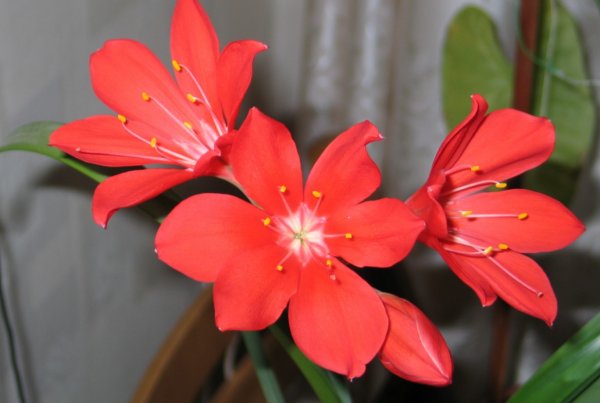
Important! As a houseplant, vallotta is not recommended for growing in homes where there are small children and pets. All parts of the plant contain poisonous toxic substances
Their concentration is especially high in the bulb.
As a precaution, it is recommended to wash your hands after transplanting or pruning a flower
Reproduction and planting of a vallot on their own
Some growers manage to find vallotta bulbs in a specialized store, in fact, this is a great success, since exotics can be found very rarely on sale. For those who are familiar with this wonderful plant, they jointly try to propagate the vallotta to obtain new beautiful specimens. For planting a plant with a bulb, a small pot is taken, which should be narrow. The fact is that with a large amount of space with soil mixture, the plant will begin to multiply very quickly by children, which will affect the flowering of the perennial. As a soil, you can use compositions based on humus, leafy earth and sod, with the addition of sand and peat. Some growers fertilize the soil with mullein or bone meal. Ready-made mixtures purchased from a specialized store are suitable.
The vallotta bulb can be planted during the summer season in nutritious open ground. If it is young, that is, only acquired, then the plant can be easily grown in the garden as an annual or perennial (in warm regions) culture. When transplanting a vallot for a while, make sure that the roots are not damaged in the process, any even the slightest damage can lead to decay. If you are not confident in your abilities, then the bulb is left in a container for the summer and taken out into the fresh air for sunbathing.
For propagation of the vallot, you can use seeds, cuttings of the bulb or children, which it forms from the top of the tuber. In any case, some problems may arise during cultivation, since the plant needs supervision from the earliest stages of life. To get seeds from your plant at home, after flowering, the largest ovary is left on the peduncle, as soon as it dries up and begins to crack, then it's time to collect planting material. In no case should you hesitate with the process, since the germination of seeds usually lasts for several weeks. Sowing is performed immediately after collection, the material is sown on the surface of a wet substrate, based on sod, leafy soil with the addition of peat in equal proportions. To lighten the soil, you need to add sand, which in the ratio with the turf should be 2/1. The first friendly shoots will appear in 3-4 weeks when kept under a film and a temperature of 16-18 degrees. Monitor the moisture content of the substrate by airing the greenhouse with seedlings daily. It is possible to dive a plant in separate containers only after six months. Youngsters are seated in permanent pots in the second year in the fall, after which the winter, until April, is kept in hibernation at a low temperature in a well-lit place. Vallota blooms only for 3-4 years.

The simplest division of the vallot is with the help of "children", which she forms very willingly. A new plant is cut from the mother bush only when it has developed its own root system and several green parts. Only such young growth can easily take root in a new place. If you cut the bulbs that have no roots, they will die within a few days. Some growers recommend waiting until the bulb falls off by itself, only then should it be removed from the parent specimen.

Features of caring for a wallot at home
Some growers, due to the peculiarities of caring for a vallot at home, laugh that the worse it is to take care of it, the brighter and more beautiful it blooms. But, nevertheless, some of the nuances are worth knowing, since if improperly performed, the plant can wither and die.
First of all, pay attention to the temperature of the content of the vallot - in the winter season, especially for young specimens, a state of dormancy is required, which lasts from late October to April. At this time, the plant must be kept in a room with 10-12 degrees of heat.
A short-term decrease is allowed up to 5-8. Before the start of the growing season, the temperature gradually rises and in the active period it is 20-25 degrees.
During the period of active growth and development, the vallotta flower prefers moderate watering with soft melt water without excess lime. It is recommended to introduce moisture only when the upper earth layer dries out. By the wintering period, watering is gradually reduced from late autumn to March, the plant is not recommended to be watered. Since March, water procedures have also been gradually resumed.
The illumination of the Vallot flower loves intensely bright, but in hot weather it is better to shade it from direct sunlight and spray it from a spray bottle. As top dressing, liquid fertilizers are used for indoor flowering plants, which are applied during the growing season at a frequency of 1 time in 2 weeks.


